MAJ. GEN. SEAN GAINEY, CAPT. CHRIS PITFIELD
In 1903, the Wright brothers invented the first successful airplane. By 1914, just over a decade after its successful test, aircraft would be used in combat in World War I, with capabilities including reconnaissance, bombing and aerial combat. This has been categorized by most historians as a revolution in military affairs. The battlefield, which previously included land and sea, now included the sky, permanently altering the way wars are fought. With the new technology came new strategy, policy, tactics, procedures and formations.
Twenty years ago, unmanned aircraft systems (UASs) were much less prevalent and capable. Today, their threat potential and risk profile have increased significantly. UASs are becoming increasingly more affordable and capable, with improved optics, greater speed, longer range and increased lethality.
The U.S. has long been a proponent of utilizing unmanned aircraft systems, with the MQ-9 Reaper and MQ-1 Predator excelling in combat operations, and smaller squad-based UASs being fielded, such as the RQ-11 Raven and the Switchblade. While the optimization of friendly UAS capability can yield great results on the battlefield, adversarial use of unmanned aircraft systems can be devastating.
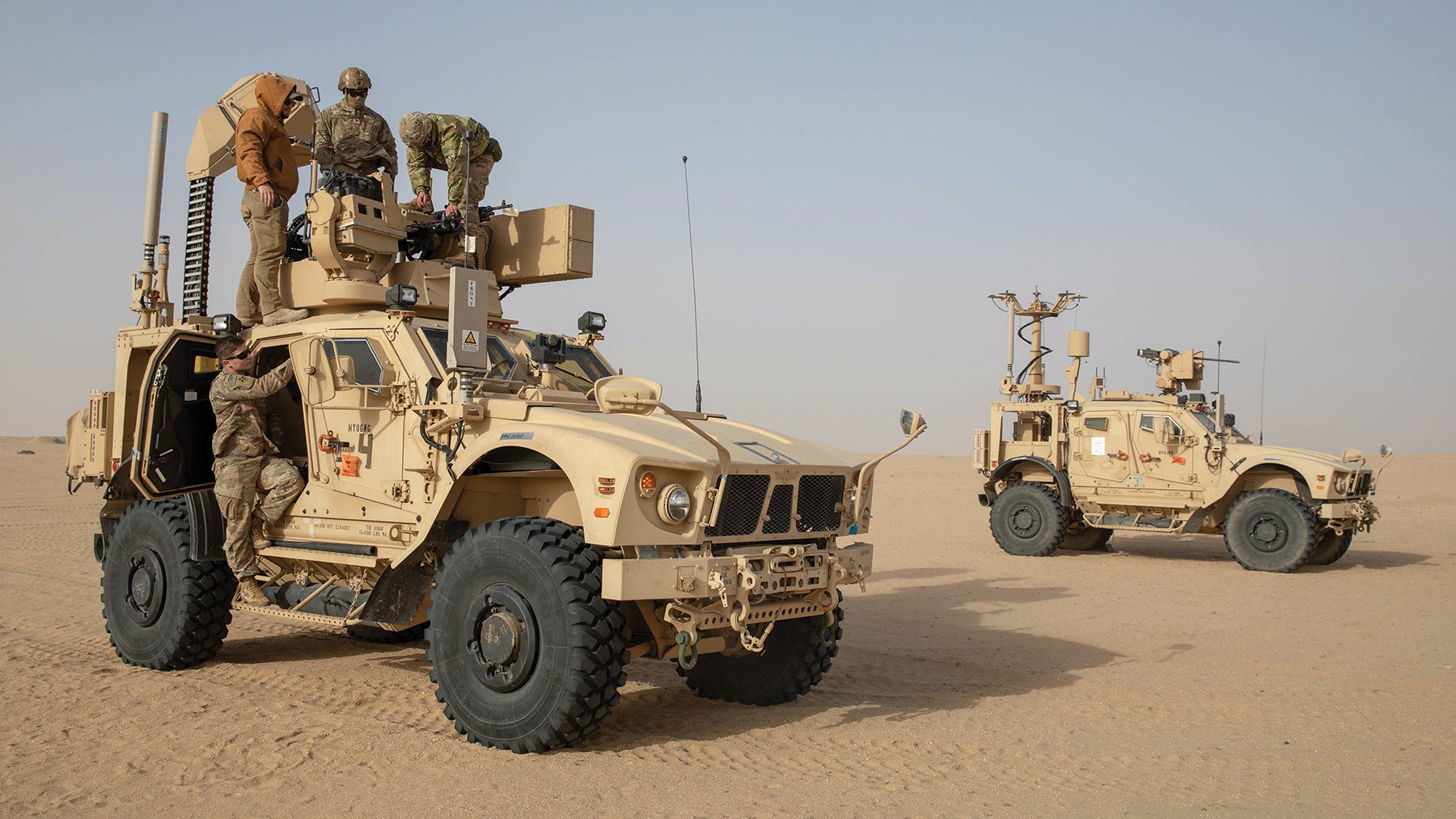 Soldiers with the 1st Stryker Brigade Combat Team, 4th Infantry Division, conduct counter-small drone training at Camp Buehring, Kuwait. (Credit: U.S. Army/Spc. Damian Mioduszewski)
Soldiers with the 1st Stryker Brigade Combat Team, 4th Infantry Division, conduct counter-small drone training at Camp Buehring, Kuwait. (Credit: U.S. Army/Spc. Damian Mioduszewski)This began to raise serious concerns due to use by nonstate actors such as Houthi rebels in Yemen and the Islamic State group in the Middle East.
Now, in addition to nonstate actors, there are multiple examples of peer-to-peer conflict in which UASs have been fielded to great effect. Azerbaijan’s use of Israeli Harops and Turkish Bayraktar TB2 unmanned aircraft systems in the 2020 Nagorno-Karabakh conflict led to what many have described as a decisive victory in terms of territory gained and damage inflicted. The UASs used in this conflict have set the stage, with many countries working with Israel and Turkey to acquire these game-changing capabilities. In the conflict in Ukraine, the Bayraktar TB2 has shown great promise, dealing devastating damage against the Russian incursion.
Today, “everyone has access to unmanned aerial systems. They are very easy to make lethal,” Army Chief of Staff Gen. James McConville said in March. As manned aircraft gained prominence on the battlefield, so too did anti-aircraft weaponry. Similarly, UAS proliferation across the battlefield has led to the requirement for counter-unmanned aircraft systems.
The Solution
To combat this threat, DoD established a grouping system for UASs with five tiers, each tier relating to an increase in size, speed and maximum altitude. Conventional air defense artillery capabilities and tactics can engage the larger group 4 and 5 UASs; however, engaging groups 1 through 3, now defined as small UASs, required a new approach.
Each of the services independently initiated efforts to acquire service-unique counter-small unmanned aircraft system materiel solutions, and began the development of associated employment tactics and strategies. Each service reacted to the threat individually based on its understanding of the problem from applicable intelligence reports and observed employment of small UASs on the battlefield.
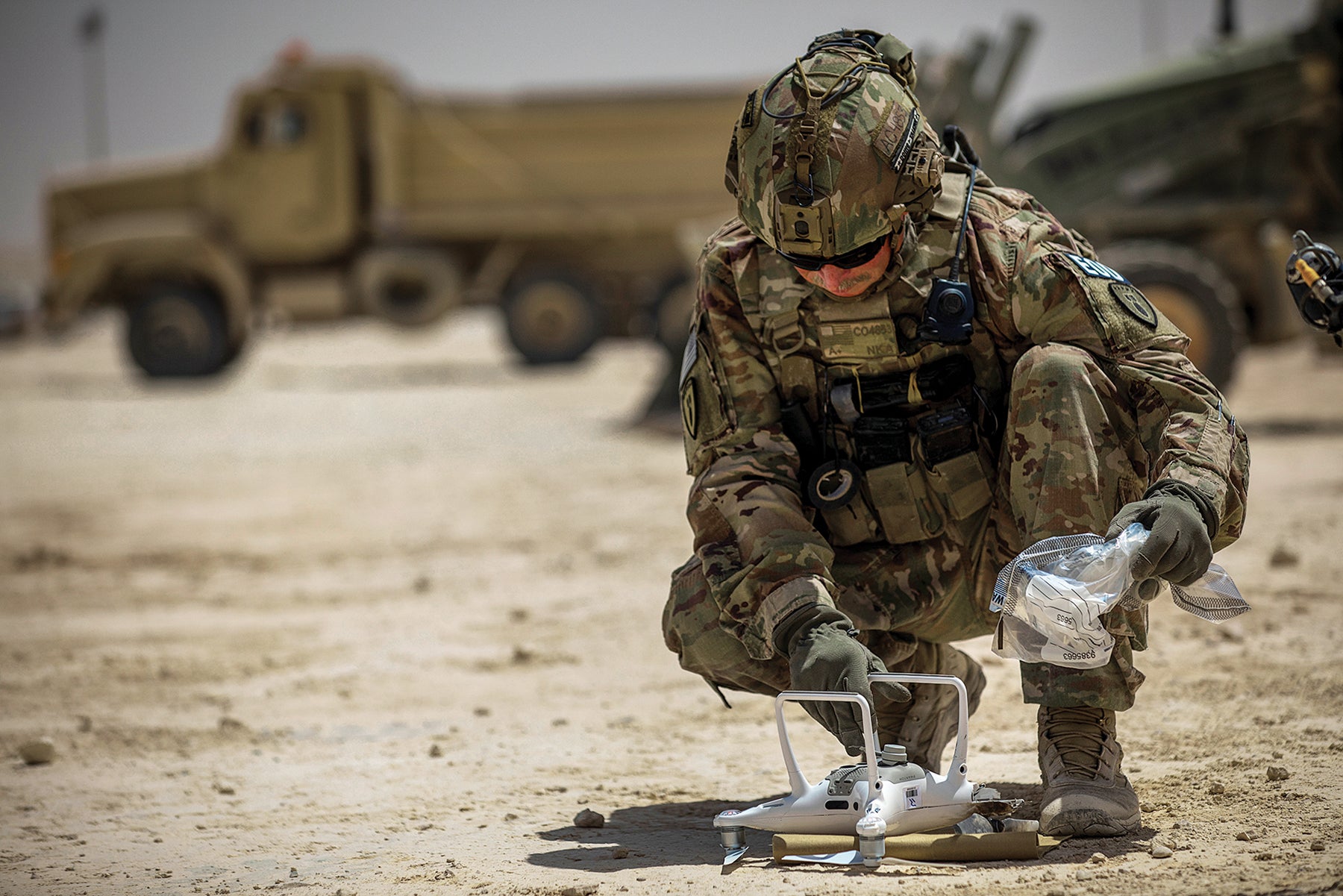 Sgt. 1st Class Adrian Coghill, an explosive ordnance disposal technician, sets up a remote-controlled ordnance disposal drone at the Ain al-Asad air base, Iraq. (Credit: U.S. Army/Spc. Derek Mustard)
Sgt. 1st Class Adrian Coghill, an explosive ordnance disposal technician, sets up a remote-controlled ordnance disposal drone at the Ain al-Asad air base, Iraq. (Credit: U.S. Army/Spc. Derek Mustard)Services began to research, oftentimes with unintended overlap, which led to redundant and higher development costs across DoD, and less effective and efficient training and employment in support of joint force operations.
In November 2019, to counter this constantly evolving threat and decrease duplication and redundancy, the secretary of defense assigned the secretary of the Army as the DoD executive agent for counter-small UASs. To accomplish this mission, the secretary of the Army established the Joint Counter-Small Unmanned Aircraft Systems Office. This office leads the development of flexible, agile and safely integrated emerging joint counter-small UAS capabilities by emphasizing rapid innovation, synchronizing materiel and nonmateriel solutions, and fostering partnerships, which enable the protection of DoD personnel, facilities and assets within the homeland, host nations and contingency locations.
Comprehensive Strategy
Just over a year after its inception, the Joint Counter-Small Unmanned Aircraft Systems Office published the first DoD counter-small UAS strategy. This unclassified document serves to bring DoD counter-small UAS stakeholders into alignment through a jointly developed strategic framework and three strategic objectives. These objectives are to:Enhance the joint force through innovation and collaboration to protect DoD personnel, assets and facilities in the homeland, host nations and contingency locations.
Develop materiel and nonmateriel solutions that facilitate the safe and secure execution of DoD missions and deny adversaries the ability to impede the joint force’s objectives.
Build and broaden DoD’s relationships with allies and partners to protect American interests at home and abroad.
These objectives are to be achieved through three key lines of effort: Ready the force, defend the force, and build the team. These lines of effort are outlined in great depth in the implementation plan, a supporting document to the DoD counter-small UAS strategy. These two documents, approved by the secretary of defense, ensure joint counter-small UAS efforts are synchronized and provide required guidance and direction to stakeholders for counter-small UAS efforts.
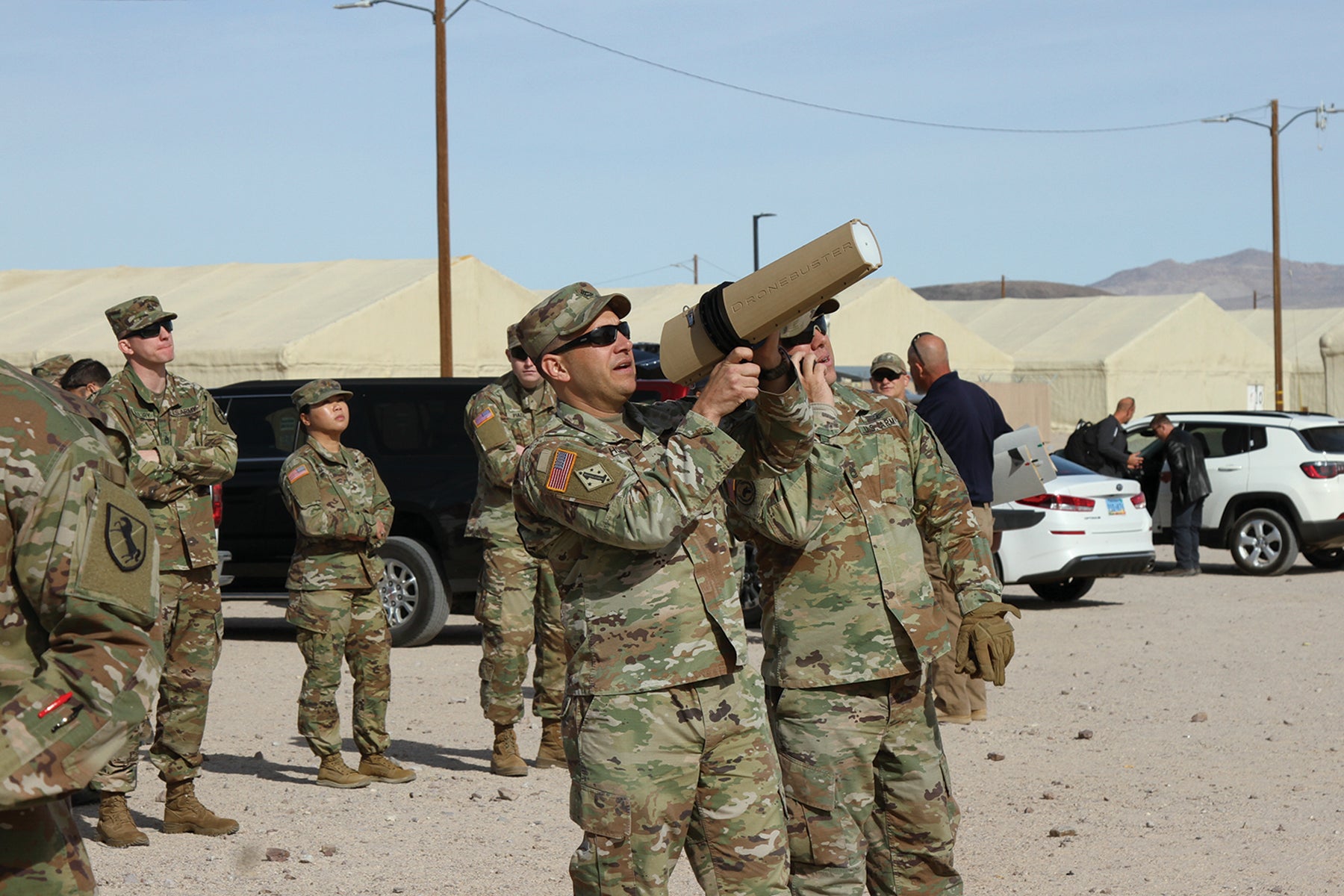
A soldier demonstrates a Dronebuster counter-unmanned aircraft system at Fort Irwin, California. (Credit: U.S. Army/Pfc. Gower Liu)
System-of-Systems Approach
In the business of warfare, there are no silver bullets. With this in mind, through research, development, testing and evaluation, the Joint Counter-Small Unmanned Aircraft Systems Office and the services are identifying systems that are interoperable and work within the defined system of systems that will address the threat of UAS use by adversaries across a broad range of conditions and environments.
Utilizing a shared command and control architecture that is interoperable across the joint force, the systems being developed utilize a broad range of detect, track, identify and defeat capabilities that, when coupled with classic air defense techniques and principles, create a layered defense, capable of mitigating a wide range of threats.
To expedite progress toward this system-of-systems approach, the Joint Counter-Small Unmanned Aircraft Systems Office works to reduce redundancy and streamline funding for the development of materiel solutions. In its initial phase, the office conducted a baseline assessment of the current efforts and used that assessment to focus DoD funding on the development of 10 identified systems, which made up the initial joint counter-small UAS capability.
To fully address the counter-small UAS mission, these 10 initial systems contained a variety of capabilities, to include detection, engagement, and command and control. In the realm of engagement, the systems chosen include directed energy, electronic warfare and kinetic capabilities. To ensure warfighters can defend themselves from the small UAS threat at any point during a conflict, the initial 10 systems cover hand-held, mounted and fixed-site options.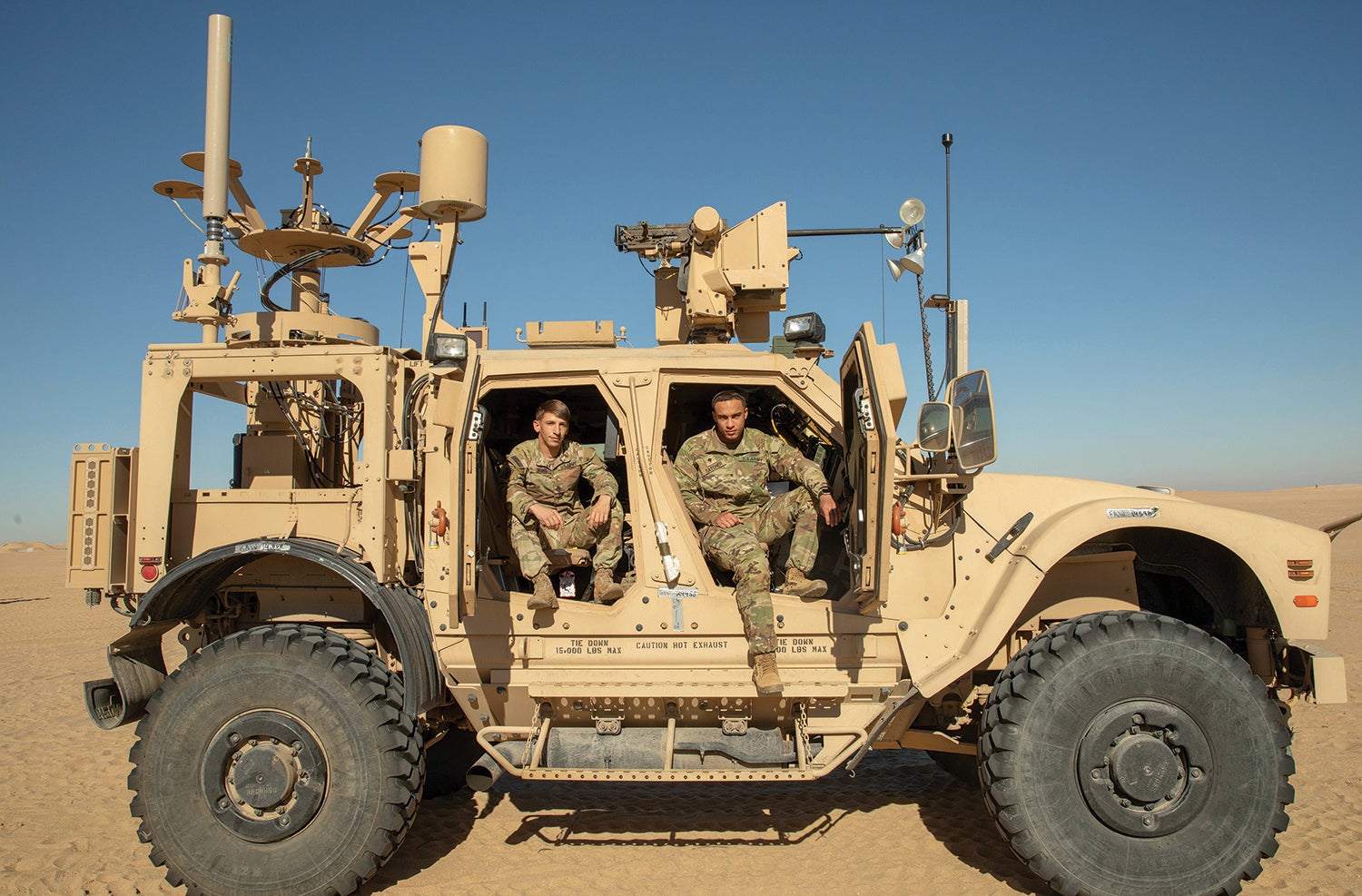

At Camp Buehring, Kuwait, soldiers with the 1st Stryker Brigade Combat Team, 4th Infantry Division, participate in counter-small drone training. (Credit: U.S. Army/Damian Mioduszewski)
Technical Demonstrations
In an effort to ensure there is constant advancement across the select counter-small UAS capabilities and that DoD stays ahead of threats, the Joint Counter-Small Unmanned Aircraft Systems Office conducts a technical demonstration twice a year. This event, jointly hosted by the office and the Army’s Rapid Capabilities and Critical Technologies Office and attended by the services, allows industry to show off developmental capabilities on a fully instrumented test range with a predefined technical focus area. Past focus areas have included hand-held solutions, low-collateral effects interceptors, high-power microwave (a component of the directed energy engagement concept) and Counter-Small Unmanned Aircraft Systems as a Service.
These events provide a platform for both traditional and nontraditional companies to help with the rapid advancement of DoD’s counter-small UAS portfolio that closes gaps, informs requirements and promotes innovation.
The most recent demonstration took place April 4–22 at Yuma Proving Ground, Arizona. It focused on ground-based, high-power microwave systems and a concept known as Counter-Small Unmanned Aircraft Systems as a Service. The ground-based high-power microwave systems at the demonstration were capabilities that produced electromagnetic pulses from a fixed ground location with enough energy to destroy or defeat airborne small UAS threats.
The Counter-Small Unmanned Aircraft Systems as a Service concept involves contractor-owned, government-operated counter-small UAS capabilities used to defend fixed locations by detecting, tracking, identifying and defeating small unmanned aircraft system threats. Future demonstrations will be conducted as the Joint Counter-Small Unmanned Aircraft Systems Office and the service identify the focus areas that provide the best potential for transitioning emerging solutions into production capabilities.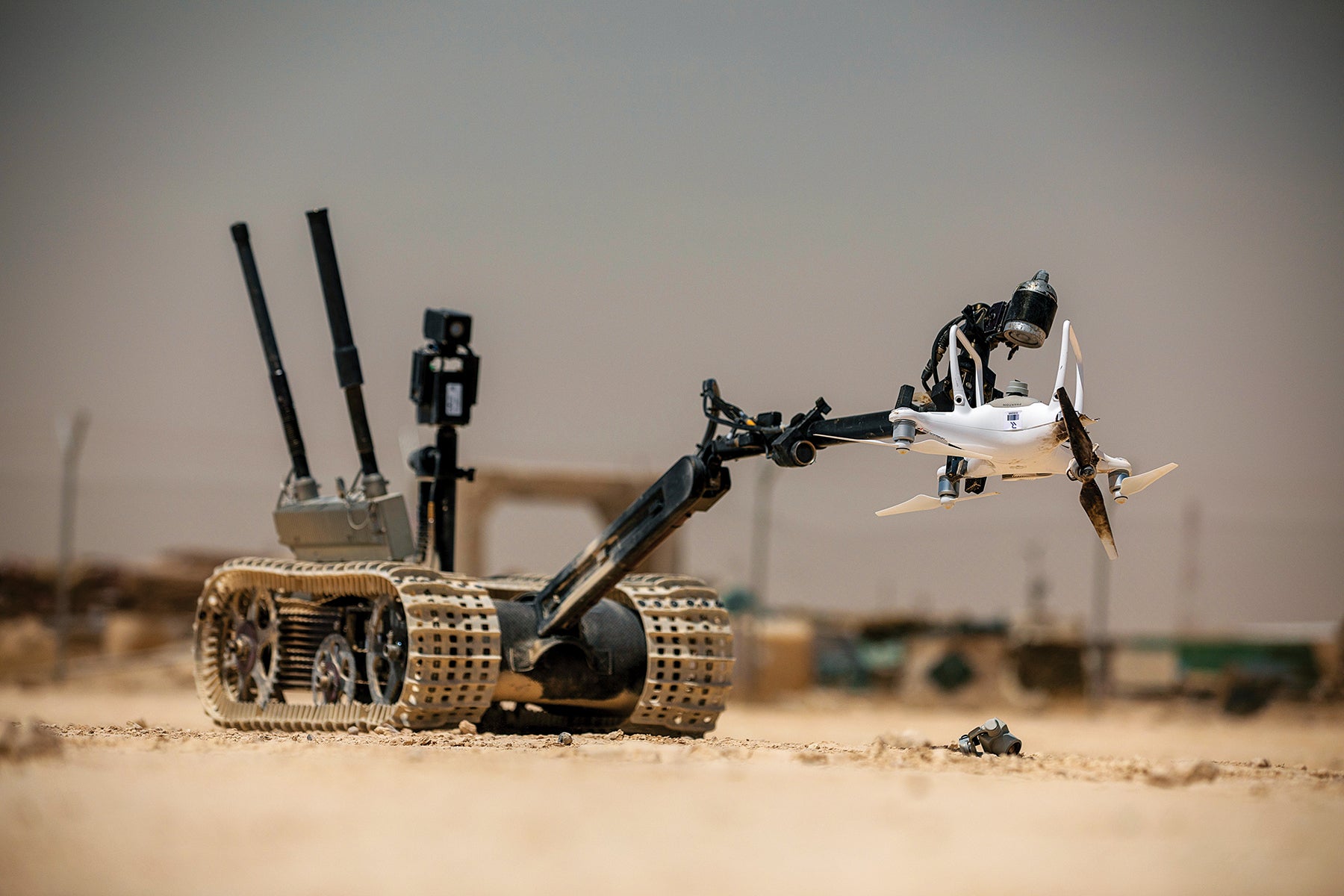 A Talon robot picks up a downed drone at the Ain al-Asad air base, Iraq. (Credit: U.S. Army/Spc. Derek Mustard)
A Talon robot picks up a downed drone at the Ain al-Asad air base, Iraq. (Credit: U.S. Army/Spc. Derek Mustard)
 A Talon robot picks up a downed drone at the Ain al-Asad air base, Iraq. (Credit: U.S. Army/Spc. Derek Mustard)
A Talon robot picks up a downed drone at the Ain al-Asad air base, Iraq. (Credit: U.S. Army/Spc. Derek Mustard)Rapid Response Team
Another important initiative within the Joint Counter-Small Unmanned Aircraft Systems Office is the Rapid Response Team. This team is a collaborative effort between the office and the Defense Digital Service, and serves to triage gaps in counter-small UASs identified by the services and combatant commands. These gaps are filled through a mix of software, additional training, hardware upgrades, etc.
The team has traveled to Europe, the Middle East, Africa and the Indo-Pacific at the request of theater leaders to assist with deep analysis of the operational and threat environment, technical and materiel recommendations, and assessment and modifications of tactics, techniques, procedures and training that inform leaders within combatant commands about current counter-small UAS best practices and developments.
Army Efforts
The secretary of the Army, while being the executive agent for the DoD, is also aware of the Army’s service-specific need for counter-small UAS efforts. “The Army needs to be very attentive to challenges like counter-UAS, for example. … Those are absolutely areas that we need to be working on in terms of developing our capabilities,” Army Secretary Christine Wormuth said in May 2021 during a Senate Armed Services Committee hearing. There are Army-specific counter-small UAS initiatives and efforts that also must be highlighted, in addition to the work the Army is doing as the executive agent.
In the context of the proliferation of the small UAS threat across the battlefield, the Army approaches counter-small UASs from both a force protection and an air defense perspective. With that said, some select duties related to counter-small UASs ideally would be MOS agnostic, with capabilities integrated into all echelons and formations from squad to theater. Every soldier has some level of responsibility in keeping their units, missions and facilities safe from small UAS threats.
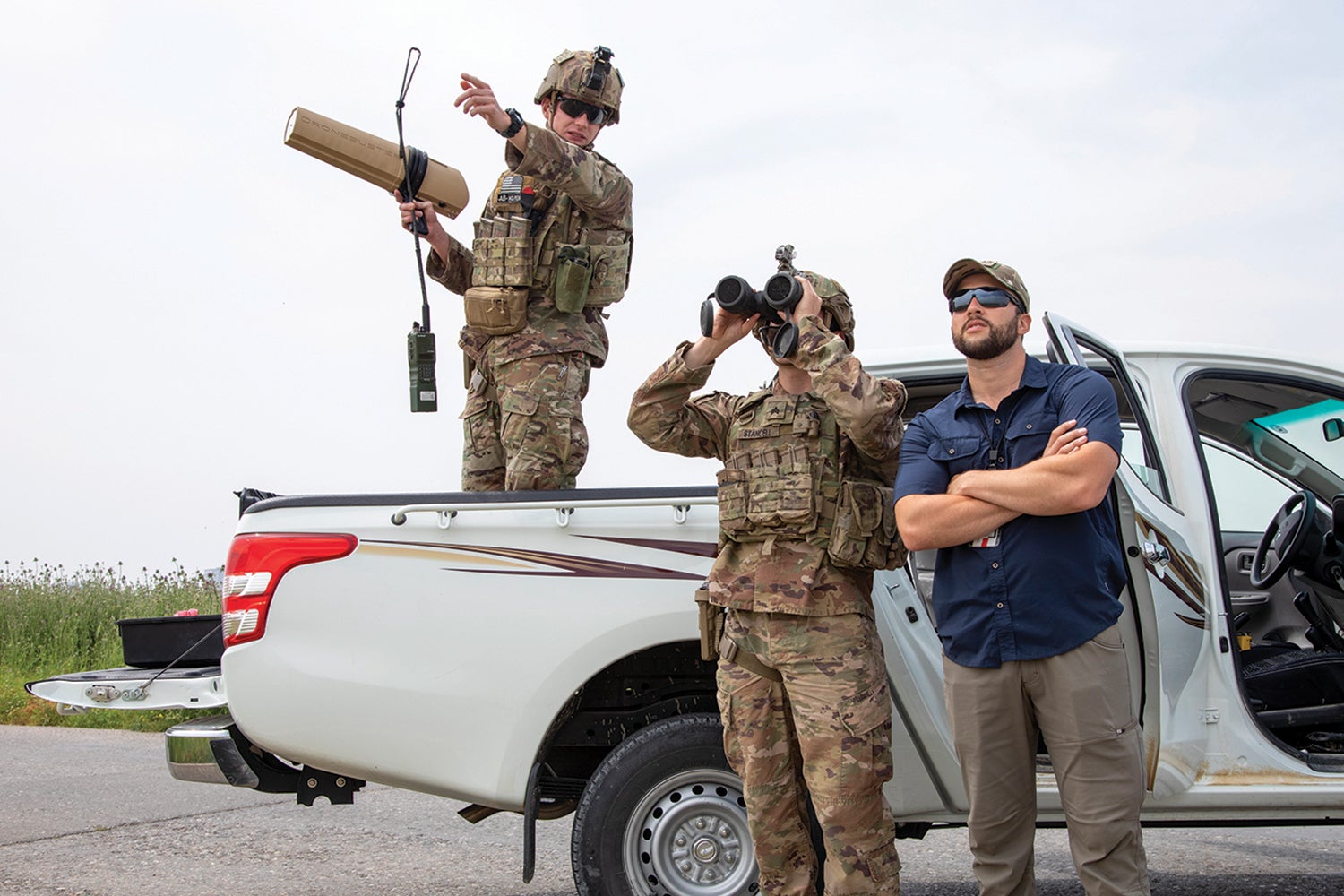 Sgt. Gentry Squier, left, points out a drone to Sgt. Gage Stancell during training at Erbil Air Base, Iraq. (Credit: U.S./Spc. Angel Ruszkiewicz)
Sgt. Gentry Squier, left, points out a drone to Sgt. Gage Stancell during training at Erbil Air Base, Iraq. (Credit: U.S./Spc. Angel Ruszkiewicz)In order to leverage existing experience within the Army, the Fires Center of Excellence, in conjunction with the Joint Counter-Small Unmanned Aircraft Systems Office, will assist the joint force with nonmateriel counter-small UAS efforts while materiel solution requirements, funding and procurement efforts process through appropriate service-specific channels. These nonmateriel efforts include establishing joint training and doctrine.
As one of the directed initiatives from the DoD counter-small UAS strategy and implementation plan, the Fires Center of Excellence, with support from the Joint Counter-Small Unmanned Aircraft Systems Office, will relocate counter-small UAS training from Yuma Proving Ground to Fort Sill, Oklahoma. The establishment of the Joint Counter-Small Unmanned Aircraft Systems Academy at Fort Sill not only will improve soldiers’ ability to defend themselves, but also will provide comprehensive counter-small UAS training for joint warfighters across all services and potentially expand in the future to include allies and partners.
Critical Work
As the global environment becomes increasingly complex and dangerous, the work the Joint Counter-Small Unmanned Aircraft Systems Office is doing in the counter-small UAS mission area is critical to ensuring that joint warfighters stay ahead of their adversaries. “We cannot expect to be ready for the next fight relying on equipment, training, tactics and operations geared toward the last fight,” Gen. Michael Garrett, commanding general of the U.S. Army Forces Command, wrote in an April 2021 ARMY magazine Commentary.
As seen in the conflicts in Eastern Europe over the past few years, leveraging small UASs can decisively turn the tide of battle in short order. Ongoing and planned counter-small UAS initiatives will ensure the success of U.S. forces in current and future conflicts. These initiatives are bringing an enterprise approach that enables the protection of personnel, materiel and missions from the growing threats and hazards associated with the rapid increase in small UAS technology.
DoD is making progress in creating a force trained and equipped to counter the undeniable threat adversary small unmanned aircraft systems represent. But this threat is rapidly and ever advancing, and will require a dynamic approach that continues to leverage efforts from across DoD, allies and partners, industry and academia. This is a fight we can and must win.
No comments:
Post a Comment